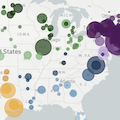Abstract
It has been 20 years since West Nile virus first emerged in the Americas, and since then, little progress has been made to control outbreaks caused by this virus. After its first detection in New York in 1999, West Nile virus quickly spread across the continent, causing an epidemic of human disease and massive bird die-offs. Now the virus has become endemic to the United States, where an estimated 7 million human infections have occurred, making it the leading mosquito-borne virus infection and the most common cause of viral encephalitis in the country. To bring new attention to one of the most important mosquito-borne viruses in the Americas, we provide an interactive review using Nextstrain: a visualization tool for real-time tracking of pathogen evolution (nextstrain.org/WNV/NA). Nextstrain utilizes a growing database of more than 2,000 West Nile virus genomes and harnesses the power of phylogenetics for students, educators, public health workers, and researchers to visualize key aspects of virus spread and evolution. Using Nextstrain, we use virus genomics to investigate the emergence of West Nile virus in the U S, followed by its rapid spread, evolution in a new environment, establishment of endemic transmission, and subsequent international spread. For each figure, we include a link to Nextstrain to allow the readers to directly interact with and explore the underlying data in new ways. We also provide a brief online narrative that parallels this review to further explain the data and highlight key epidemiological and evolutionary features (nextstrain.org/narratives/twenty-years-of-WNV). Mirroring the dynamic nature of outbreaks, the Nextstrain links provided within this paper are constantly updated as new West Nile virus genomes are shared publicly, helping to stay current with the research. Overall, our review showcases how genomics can track West Nile virus spread and evolution, as well as potentially uncover novel targeted control measures to help alleviate its public health burden.
